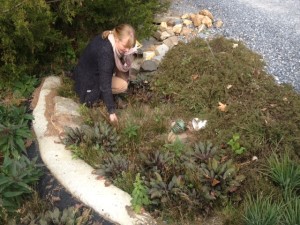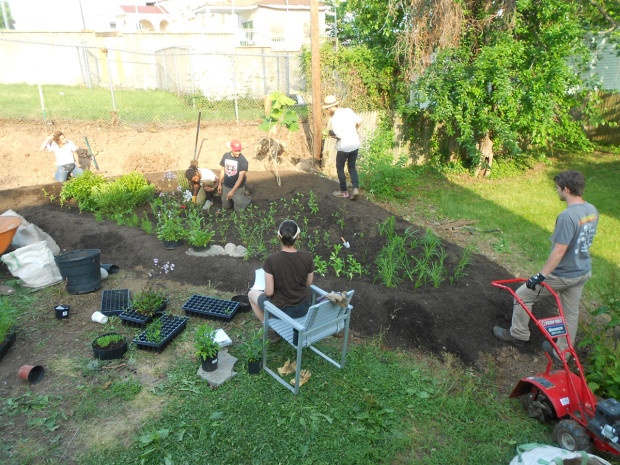We have much more to do and your continued support is needed now more than ever.
Your Backyard: A Stormwater Sponge
As urban areas have grown, we have altered nature, replacing it with sidewalks, parking lots, roads, and other man-made structures. Our development patterns have not only led to harmful levels of greenhouse gas emissions in the atmosphere, causing the climate to change, but they have also made our neighborhoods more vulnerable to flooding from stormwater. In the coming years, we can expect flooding events to intensify in frequency and severity in most regions of the U.S., including areas where average annual rain or snow is expected to decline, but especially in areas that are expected to become wetter, such as the Midwest and the Northeast. Intense rainstorms can trigger sewer overflows that pose a hazard to public health and aquatic ecosystems, as Superstorm Sandy demonstrated in 2012.

The stormwater and sewage infrastructure of many communities can’t meet the demand. When rain or snow is not absorbed into the ground, the water that remains becomes stormwater runoff. When it rains, this runoff travels over impervious surfaces, like sidewalks, streets, and even lawns, and travels towards water bodies. This stormwater carries pollutants, like motor oil, fertilizers, and pesticides, as well as trash, which all make their way into our streams and harbors. Intense rain storms, which are becoming more frequent, can trigger combined sewer overflows, which occur when stormwater mixes with wastewater and floods basements, city streets, and is even discharged into our streams, rivers, and lakes.
Make Your Yard A Wildlife-Friendly Stormwater Sponge
The way we design and manage our yards can actually help us be part of the solution, and not the problem. You have the tools to re-imagine your yard to include plants more suited for a changing climate, such as native species that are more drought-tolerant, while also creating suitable habitats for wildlife. For example, National Wildlife Federation’s Certified Wildlife Habitat ® program for backyards, schoolyards, businesses and public spaces is based on the four essential needs of wildlife: food; water sources; cover; and places to raise young. While the basic requirements are not stringent, many institutions go beyond the minimum standards. Landowners can design a Certified Wildlife Habitat® in a way that not only provides habitat for wildlife, but also helps reduce the impacts that climate change has on people and wildlife.

Networks of Certified Wildlife Habitats® can help restore wildlife in cities and suburbs, capture carbon, reduce harmful temperatures, and help manage flooding and drought.
Backyard Practices To Prepare for Climate Change
- Landscape with native plants. Natural landscaping requires less maintenance and water, as well as provides homes for local wildlife.
- Install vegetative buffer zones to prevent runoff from carrying excess nutrients and reduces erosion. Vegetation in urban areas also provides cooling effects.Removing impermeable surfaces, such as pavement or asphalt, allows water to filter into the ground and reduces flooding.
- Install a drip hose to help reduce water waste and even erosion, while also saving you money on your water bills because you will use less water.
- Use a rainbarrel to capture water that can be used for re-used for watering your yard.
- Include a bioswale or raingarden into your backyard to help filter pollutants and reduce runoff by allowing water to slowly infiltrate into the ground.
- Plant and protect trees in your backyard and in your neighborhood will not only help absorb stormwater, but will also provide shade and cooling benefits which is important as temperatures rise.
Become a Wildlife Gardener with National Wildlife Federation. It’s free and you’ll get great wildlife gardening tips and learn how to certify your garden as an official habitat.
The Climate-Smart Communities website has more information about working with nature to prepare for the impacts of climate change, and read more about creating wildlife habitats in cities.
Check out these examples of community programs
The Rainscapes Progam in Montgomery County, MD, offers rebates to residential and commercial properties that implement eligible rainscaping techniques to reduce stormwater pollution. Techniques include rain gardens, planting a tree canopy, using green roofs and rain barrels, and others.
King County, WA, is encouraging citizens to use rain barrels to store water to be used in landscaping and gardening during droughts





















